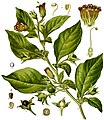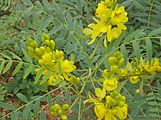Phytochemical basis

All plants produce chemical compounds which give them an evolutionary advantage, such as defending against herbivores or, in the example of salicylic acid, as a hormone in plant defenses. These phytochemicals have potential for use as drugs, and the content and known pharmacological activity of these substances in medicinal plants is the scientific basis for their use in modern medicine, if scientifically confirmed. For instance, daffodils (Narcissus) contain nine groups of alkaloids including galantamine, licensed for use against Alzheimer's disease. The alkaloids are bitter-tasting and toxic, and concentrated in the parts of the plant such as the stem most likely to be eaten by herbivores; they may also protect against parasites.
Modern knowledge of medicinal plants is being systematised in the Medicinal Plant Transcriptomics Database, which by 2011 provided a sequence reference for the transcriptome of some thirty species. The major classes of pharmacologically active phytochemicals are described below, with examples of medicinal plants that contain them.
Alkaloidsedit
Alkaloids are bitter-tasting chemicals, very widespread in nature, and often toxic, found in many medicinal plants. There are several classes with different modes of action as drugs, both recreational and pharmaceutical. Medicines of different classes include atropine, scopolamine, and hyoscyamine (all from nightshade), the traditional medicine berberine (from plants such as Berberis and Mahonia),b caffeine (Coffea), cocaine (Coca), ephedrine (Ephedra), morphine (opium poppy), nicotine (tobacco),c reserpine (Rauvolfia serpentina), quinidine and quinine (Cinchona), vincamine (Vinca minor), and vincristine (Catharanthus roseus).

The opium poppy Papaver somniferum is the source of the alkaloids morphine and codeine.

The alkaloid nicotine from tobacco binds directly to the body's Nicotinic acetylcholine receptors, accounting for its pharmacological effects.

Deadly nightshade, Atropa belladonna, yields tropane alkaloids including atropine, scopolamine and hyoscyamine.
Glycosidesedit
Anthraquinone glycosides are found in medicinal plants such as rhubarb, cascara, and Alexandrian senna. Plant-based laxatives made from such plants include senna, rhubarb and Aloe.
The cardiac glycosides are powerful drugs from medicinal plants including foxglove and lily of the valley. They include digoxin and digitoxin which support the beating of the heart, and act as diuretics.

Senna alexandrina, containing anthraquinone glycosides, has been used as a laxative for millennia.

The foxglove, Digitalis purpurea, contains digoxin, a cardiac glycoside. The plant was used on heart conditions long before the glycoside was identified.

Digoxin is used to treat atrial fibrillation, atrial flutter and sometimes heart failure.
Polyphenolsedit
Polyphenols of several classes are widespread in plants, having diverse roles in defenses against plant diseases and predators. They include hormone-mimicking phytoestrogens and astringent tannins. Plants containing phytoestrogens have been administered for centuries for gynecological disorders, such as fertility, menstrual, and menopausal problems. Among these plants are Pueraria mirifica, kudzu, angelica, fennel, and anise.
Many polyphenolic extracts, such as from grape seeds, olives or maritime pine bark, are sold as dietary supplements and cosmetics without proof or legal health claims for beneficial health effects. In Ayurveda, the astringent rind of the pomegranate, containing polyphenols called punicalagins, is used as a medicine.

Angelica, containing phytoestrogens, has long been used for gynaecological disorders.

Polyphenols include phytoestrogens (top and middle), mimics of animal estrogen (bottom).
Terpenesedit
Terpenes and terpenoids of many kinds are found in a variety of medicinal plants, and in resinous plants such as the conifers. They are strongly aromatic and serve to repel herbivores. Their scent makes them useful in essential oils, whether for perfumes such as rose and lavender, or for aromatherapy. Some have medicinal uses: for example, thymol is an antiseptic and was once used as a vermifuge (anti-worm medicine).

The essential oil of common thyme (Thymus vulgaris), contains the monoterpene thymol, an antiseptic and antifungal.

Thymol is one of many terpenes found in plants.










Comments
Post a Comment